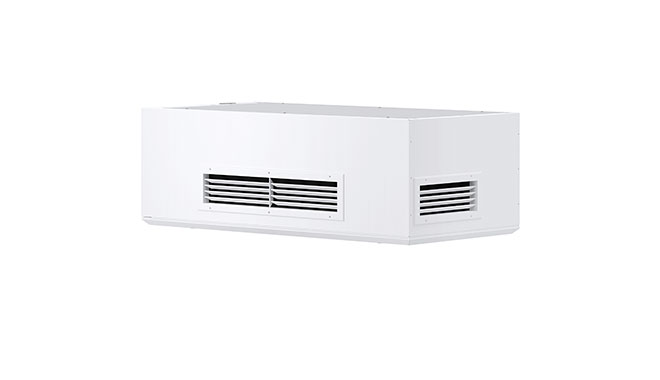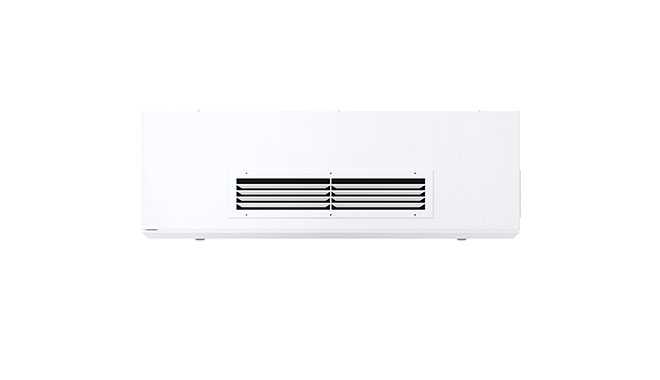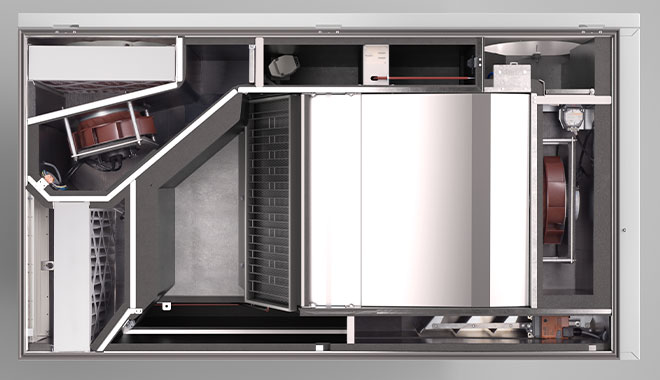VRL-C G Premium
- Decentralised ventilation unit with heat recovery for schools, childcare centres, offices and community halls
- Up to 92% heat recovery
- Easy installation, even in retrofit projects
- Additional accessories include CO2 sensor and motion sensor
Product Overview
Ventilation for schools, restaurants and offices
The VRL-C decentralised heat recovery ventilation system recovers up to 92% of the heat that would otherwise be lost through an open window. With decentralised ventilation, the ventilation system is installed where it is needed — directly inside your classroom. Installation is simple and can be implemented quickly. In this way, individual devices ensure optimal ventilation of the entire classroom independently of one another — the old air out, fresh and the healthy air in.
Product Details
Application
Typical applications are the controlled ventilation of larger rooms such as classrooms, meeting rooms, child-care centres, restaurants and event rooms. Thanks to the integrated filter and heat recovery, the automatic room ventilation improves the air quality in the room and lowers the proportion of CO2, aerosols, spores and dirt. At the same time, the permanent air exchange reduces the pollution of the room air with odours, bacteria and viruses.
The sound-optimised, quiet devices are designed for decentralised use directly in the usage unit. Air ducts are required for the outside and exhaust air. The exhaust air and supply air are distributed directly via the grille outlets on the device.
Comfort features
Operating modes, programs and parameters can be set easily and intuitively with the control unit. The devices are easy to maintain and designed for quick and easy service. An additional sensor (accessory) measures the CO2 concentration of the room air and regulates the air output of the device fully automatically until the CO2 value falls below the set value again.
The device can be switched to basic ventilation or a higher air level via a motion sensor (accessory). The temperature-controlled bypass enables the heat recovery to be bypassed automatically. The devices are all equipped with an electrical preheater and can also be used at low outside temperatures with balanced supply, and exhaust air volume flows. The systems are equipped with motorized outside and exhaust air flaps to prevent uncontrolled airflow during standstill. In the event of a fire or loss of voltage, the spring-loaded outside and exhaust air flaps close the airways and thus help to minimise the spread of fire and smoke gas in the building. In larger buildings, up to 20 devices can be connected to one another and controlled using just one control unit. The devices are connected to a higher-level building control system using BacNet, Modbus and LON interfaces (accessories).
Installation
The device is designed for ceiling mounting and can be integrated into a suspended ceiling. It can be installed in different places on the ceiling. The supply air grille, which can be adjusted for flow direction, is located on the front of the device. The exhaust air is extracted through the exhaust air grille on the narrow right-hand side.
Efficiency
Energy-saving EC fans, in conjunction with the control and other sensors, enable efficient operation.
Ducted version also available
Technical Data
| Product | VRL-C 300 G Premium | VRL-C 870 G Premium | |
| Heat recovery | Up to 92 % | ||
| Power consumption (fan max.) | 137 W | 329 W | |
| Rated voltage | 230 V | ||
| Air volume flow (m3/h) | 100-300 | 300-870 | |
| Filter class extract air | ePM10 = 50% (M5) | ||
| Filter class supply air | ePM1 ≥ 50% (F7) (F9 optional) | ||
| Air duct connection | 200 mm | 315 mm | |
| Min. Distance to ceiling | 20 mm | 20 mm | |
| Height | 407 mm | 507 mm | |
| Width | 585 mm | 902 mm | |
| Length | 1202mm | 1688mm | |
| Weight | 100 kg | 140 kg | |
Downloads
| File | Category | Type | Download |
|---|---|---|---|
Looking for BIM / Revit files? Click here! | |||
| VRL-C G Datasheet | Data Sheet | PDF 273.38 kB | |
| VRL-C Installation Guide | Operation and Installation Guide | PDF 4.85 MB | |
| VRL-C Operation Guide | Operation and Installation Guide | PDF 2.38 MB | |
| Heat Recovery Ventilation Warranty | Warranty | PDF 176.06 kB | |
| VRL-C 300 G 2D CAD DFX file | CAD Data | DXF 0.96 MB | |
| VRL-C 300 G 3D CAD STP file | CAD Data | STP 11.09 MB | |
| VRL-C 870 G 2D CAD DFX file | CAD Data | DXF 1.34 MB | |
| VRL-C 870 G 3D CAD STP file | CAD Data | STP 5.66 MB | |
| VRL-C Commissioning Checklist | Commissioning | PDF 863.58 kB | |
FAQ
Heat recovery ventilation (HRV), also known as mechanical ventilation, works by exchanging stale indoor air with fresh outdoor air while also recovering heat from the outgoing air. HRV systems include fine filtration to capture even the tiniest particles, including pollen and bacteria, ensuring that the air we breathe is clean and healthy.
One of the main benefits of a heat recovery ventilation system is that it provides continuous air exchange, which is essential for maintaining good indoor air quality. It removes pollutants and allergens from the air and can help to reduce heating and cooling costs.
Portable air purifiers can be effective at improving the air quality in a single room or small space, but they do not provide the same benefits as a heat recovery ventilation system. Portable air purifiers typically do not exchange air from outside, meaning that while the air quality in the room can be improved, the air itself is not exchanged with fresh outdoor air. This means that pollutants and other particulates can still build up over time, leading to poor indoor air quality.
Visit our HRV FAQ page



